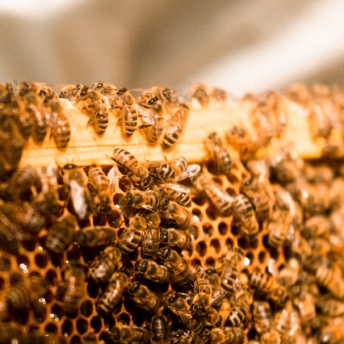
Urban Honey Bees: Is There Such A Thing As Too Many?

It’s a common assumption honey bees only reside in rural areas – be it a flower-filled meadow or an overgrown forest – but the range of habitats in which they live is actually much more diverse.
In recent years, urban bees, sometimes called city bees, have become increasingly common. Not only can honey bees survive in the city, but research suggests that they may even lead healthier lives than their countryside counterparts.
Cities often feature a wider variety of plants – providing these pollinators with more diversity – while the lower use of pesticides protects them from harmful chemicals.
Given that honey bees form an essential part of our ecosystem, it’s important to be aware of how we can support them. By helping them survive, we’re helping the whole world.


The rise of urban beekeeping
When it comes to urban beekeeping, Paris is often seen as a pioneer. While the French capital might seem like the last place you’d expect to see honey bees, beekeepers have actually been operating in the city since the 1980s.
Today, there are hundreds of hives spread all over the city – their locations ranging from famous Paris gardens, like Jardin de Luxembourg, to the roofs of famous buildings like the Notre Dame. Creating urban habitats such as these for honey bees has had a hugely positive impact on the region’s pollinator population.
It’s not just Paris though – over the past couple of decades, more and more cities have launched similar projects. Now you can find urban beekeepers working everywhere from Berlin to Tokyo. Thanks to good work by projects like the European Pollinator Initiative, whose mission is to protect pollinators and enhance biodiversity throughout Europe, many towns and cities have started inviting urban honey bees into their gardens and rooftops as well.
Urban beekeeping projects have become a crucial way for developing small-scale colonies to pollinate city green spaces, and as this practice continues to grow in popularity, the positive influence bees are having on our urban areas is only going to increase.
Concerns about urban bees
Despite this, some people have concerns about introducing more honey bees to our urban areas. While there is truth to some of these worries, it’s important to look at the wider picture. Below we’ve outlined and explained some of the main concerns people have about urban bees.
Does urban beekeeping affect other pollinators?
Many urban areas are already populated with pollinators such as butterflies, solitary bees, wasps and flies. Because of this, there’s a concern that urban honey bees might act in direct competition with them. This is something all urban beekeepers are aware of, with most taking careful steps to prevent any harmful overlap (for example, keeping track of the number of bees in each area).
Another way to avoid competition between urban honey bees and other pollinators is to ensure there are enough habitats and green spaces in our urban areas. This not only helps all types of pollinators thrive in urban areas but also improves the living conditions for everyone in the city. Supporting the health of both native city pollinators and urban bees is essential.
Are honey bees dangerous?
Some people believe that urban honey bees might pose a risk to people in public areas based on the belief that bees might chase and sting people unprovoked.
This has been proven untrue. Even when bees move as part of a swarm, they’re very unlikely to harm people. In fact, they generally have a reputation for being easy-going insects. Swarms only occur temporarily while a colony is in transit and looking for a stable home, so even though they might look scary, they’re still unlikely to attack.
It’s also worth noting that the honey bees kept in urban beehives normally have more docile characteristics bred into them. They’re comfortable around humans because they interact with them frequently, making them unlikely to harm people unless provoked or threatened.
Helping bees in urban areas
How can you help urban bees and other city-based pollinators flourish?
It’s easy: plant more flowers and let your garden grow wild or, if you don’t have a garden, try to get involved in local community groups and initiatives like the Bee Bold Awards in the South West. Whether it’s assisting with a rewilding project or helping populate the flowerbeds in your local park, every small effort goes a long way.
It’s important to plant throughout every season, including in January and February and into autumn when pollen is less abundant, to support pollinators of all kinds. If you notice your area has a large number of pollinators unable to fly as far, such as solitary or masonry bees, try finding out what they enjoy foraging on and plant accordingly near them to give them the most support!
Alternatively, you can join us at Knight’s Beekeeping. We take great care to install our hives in areas where our bees and the local pollinators can thrive in harmony, in both urban and rural habitats. Through our on-site Experience Days, guest demonstrations and social media content, we’re also raising awareness for urban pollinators and helping the public get involved in supporting them.
Looking to the future
Over the past couple of decades, urban honey bees have become a key part of our cities’ ecosystems. Not only are they good for promoting biodiversity in city green spaces, but they also support the overall health of our planet. Supporting them, and other city-based pollinators, is essential.
If you’re ready to take the first step in supporting honey bees, visit our plans and pricing page and get involved today. Alternatively, you can get in touch by filling out the form on the contact page.



